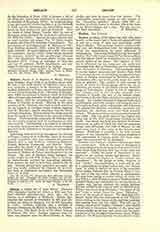

Ceslaus, Saint, b. at Kamien in Silesia, Poland (now Prussia), about 1184; d. at Breslau about 1242. He was of the noble family of Odrowatz and a relative, probably a brother, of St. Hyacinth. Having studied philosophy at Prague, he pursued his theological and juridical studies at the University of Bologna, after which he returned to Cracow, where he held the office of canon and custodian of the church of Sandomir. About 1218 he accompanied his uncle Ivo, Bishop of Cracow, to Rome. Hearing of the great sanctity of St. Dominic, who had recently raised to life the nephew of Cardinal Orsini, Ceslaus, together with St. Hyacinth, sought admission into the Order of Friars Preachers. They received the religious habit from the hands of St. Dominic in the convent of Santa Sabina. Their novitiate completed, St. Dominic sent the two young religious back as missionaries to their own country. Establishing a monastery at Friesach in Austria, they proceeded to Cracow, whence Ceslaus was sent by St. Hyacinth to Prague, the metropolis of Bohemia.
Laboring with much fruit throughout the Diocese of Prague, Ceslaus went to Breslau, where he founded a large monastery, and then extended his apostolic labors over a vast territory, embracing Bohemia, Poland, Moravia, Pomerania, and Saxony. Sometime after the death of St. Hyacinth he was chosen provincial of Poland. Whilst he was superior of the convent of Breslau all Poland was threatened by the Tatars. The city of Breslau being besieged, the people sought the aid of St. Ceslaus, who by his prayers miraculously averted the impending calamity. Four persons are said to have been raised to life by him. Having always been venerated as a saint, his cult was finally confirmed by Clement XI in 1713. His feast is celebrated throughout the Dominican Order on July 16.
A. WALDRON

